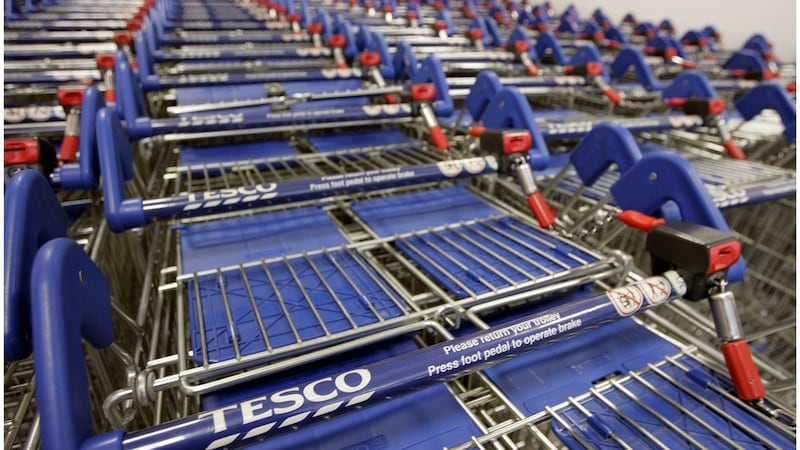When asked by The Irish Times this week to assess the impact of the cost of living crisis on their grocery spending over the last year, dozens of respondents on social media said their costs were easily up by €40 a week.
Price increases of that scale were noted irrespective of which supermarkets they shopped in. There have been hikes up and down every aisle of every shop.
“I consistently shop in Lidl for a family of five,” said Emily McElarney. “It used to cost €140ish a week [but] now I’m spending between €170 and €180.”
Yvonne Cooney noted that “absolutely everything” in her shopping trolley had gone up “and it is still rising”.
READ MORE
“It easily must be at least 25 per cent across the board. What was €80 before now coming in excess of €100 and the rest!”
“Definitely €50 plus,” said Dee Hendrick. “I shop the specials and [have] no loyalty to any particular shop. Butter has increased by €1. Milk, bread, flour and lots of basics have seen a noticeable increase.”

Tommy McGlone told The Irish Times that while he used to be “hard pushed to spend €100 in Lidl for four of us”, he was now finding it far too easy to spend €140 or €150.
“It’s easily €40 per week more for two adults,” was the assessment of Kate Ryan. “Way more if you include dog food (not bought in a supermarket because I have a desperately finicky pooch).” She said she was “definitely buying less extras and treats, and ramping up already significant efforts to not waste anything”.
Basket of items
These perspectives chimed with our own research. Last April we priced a basket of 25 commonly bought items across several supermarkets, with the cost coming in at just shy of €85.
The price of the same basket now tops €100 and based on today’s prices, a person who buys just the 25 items we selected weekly over the course of the next 12 months is going to spend €750 more than if they were able to buy them at last April’s prices.
The average increase of €40 for a full shop, meanwhile, would suggest that many Irish households would be spending as much as €2,000 more per year on groceries now than they were in 2021. It is an eye-watering figure and all the more so when you consider that that would be from net pay, meaning many will have to earn twice that just to cover the cost.
The good news is that the double-digit food price spiral recorded over the past year may at last be easing. The bad news is that the era of food price deflation and historically cheap food is almost certainly at an end.
Recent figures from retail analyst Kantar point to a 15 per cent increase in the price of groceries across the board over the past year, the highest rate of inflation ever recorded.
However, we may be past the worst of it, with the general rate of inflation easing slightly this month and fuel prices on forecourts having fallen back, albeit to still high levels.
“I don’t think there will be huge increases in the months ahead,” says retail analyst and TU Dublin academic Damian O’Reilly. “I can’t see price rises of more than 10 per cent again this year as a lot of the higher manufacturing costs and input costs are now built into the supermarkets’ cost structure.”

He stresses that while the increases might be tempered, they have not gone away. “We’re going to see inflation for the next six to eight months,” he adds, with some marked increases likely in the weeks ahead.
“Over Christmas, retailers were competing very hard for market share and prices were competitive, which will have put pressure on their margins. They were taking a hit, so I think they will probably be increasing their prices in the weeks ahead and after that they will stabilise.”
No deflation
In the longer term, O’Reilly does not see a return to the food price deflation that was evident across the Irish grocery sector in the years preceding the start of the cost-of-living crisis.
“There has definitely been a readjustment in pricing and we will see higher prices for the foreseeable future,” he says.
In his best-case estimate, consumers are likely to see grocery prices climb by somewhere between 3 and 4 per cent by the end of the year.
“With price falls unlikely, we will see more people changing their habits and I think we are already seeing more conscious consumerism. In an era of rising prices, people will have to eat more carefully and reduce the level of waste, with more leftovers and batch cooking and people buying less but making more with it,” O’Reilly adds.
His assessment was echoed by a report looking into Irish shopping habits published by Bord Bia earlier this month.

It highlights the return of the frugal shopper and says Irish consumers are embracing discounters more now than ever before, buying more own-label products than ever before and shifting towards “value” ranges offered by supermarkets rather than so-called premium lines.
Cooking from scratch is holding its own as Irish consumers look to save money by doing more for themselves. Sales of more expensive proteins like such as and seafood have suffered, with consumers seeking out foods that can be converted into more than one dish or single meal.
Sales of lamb are down 32 per cent, while seafood sales have fallen by 33 per cent, the Bord Bia research says. By contrast, chicken is selling well and stands out as an example of a food that is known to be versatile and cheaper than other meats.
Shopping lists
Grace Binchy, a trends and insight specialist with Bord Bia, says the report contains clear evidence that people are “scrutinising how they’re spending money” and shopping across multiple stores to get the best deal more often.
She notes that 51 per cent of Irish consumers are doing their shopping in multiple stores and a higher percentage are going to discounters.
”We’re creating shopping lists and sticking to them,” she says. “That allows us to have control, and we know that’s what people like in times of uncertainty.”

















